Following the big trades on Friday there has been so much discussion about the value of draft picks and the importance of the draft that I thought I would have a little fun with the numbers. A few weeks ago I looked at the record of teams following their free agent spending so this time I thought I would look closer at the impact of the draft on teams success.
To start with I went back and looked at all draft picks made between 2014 and 2019 and then calculated their pick values using the Fitzgerald-Spielberger values. I then plotted what was their record in the period following that draft class up to a maximum of four years (2018 would be 3 years and 2019 just two years at this time).
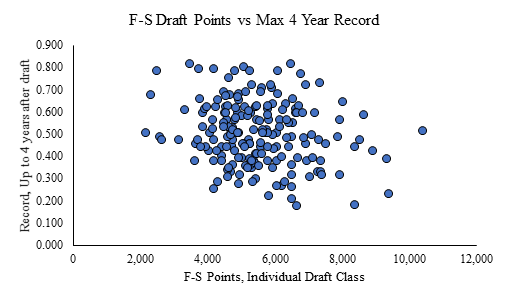
This was a little unexpected as I would have thought there would be a little more correlation between record and draft points but then again there is a thought that bad teams stay bad in the NFL and good teams (with good QBs) overcome limited draft resources. So maybe this isn’t the best way to look at it.
Instead let’s look at the average improvement over the team’s baseline going into each draft.
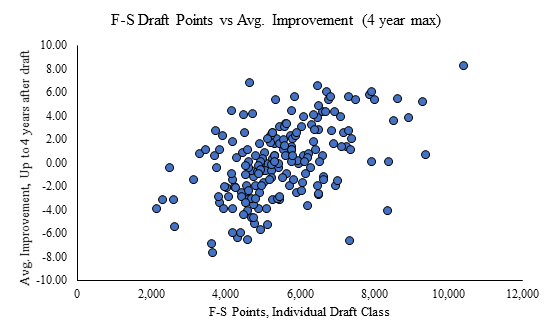
This is certainly more in line with expectations and some solid evidence that maximizing draft points through whatever means is going to help teams improve over their priors. Most of the improvement seems to come from maximizing your point allocation in the top 3 rounds of the draft.
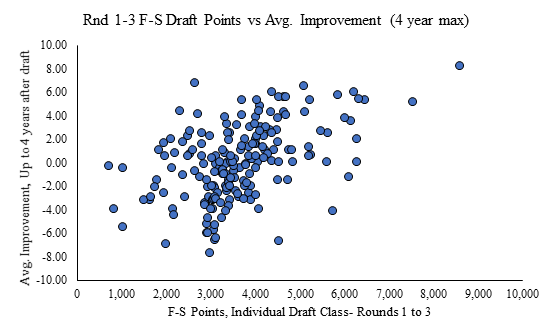

If you are curious about just round 1 here is the impact of the first round picks. Note that any team above 3,000 points is clearly a team with multiple 1s in a season (3,000 is the max points for a 1st round pick).

What if we filter out the teams with multiple 1s and no ones and just look at the results of teams with 1 first round pick (includes trade downs and ups)?
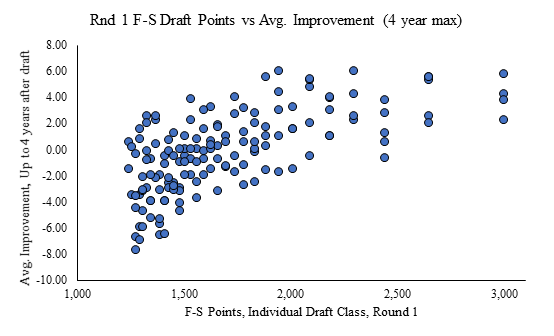
I thought this was interesting because there is a clear trend that the higher the points the more improvement we seem to be getting…up to a point. You can argue where that point is but I would say it is in the ballpark of the 6th pick in the draft (around 2,100 points) which I think gets the point where anyone in the top of the draft should strongly consider trading down unless you are picking a QB.
However the most important thing to consider is how teams do with their draft selections. Teams should exploit every possibie advantage than can find in inefficiencies in the way that we approach the draft but ultimately all the points in the world don’t help you when you make bad picks in the draft. You not only want good players in the draft but players who are going to contribute for more than just a few years.
While this is not a complete measurement since we still have players on rookie contracts, the final thing I looked at was the actual performance of the rookies who were drafted. To do that I looked at every player drafted from 2014 to 2017 and determined what was the value of their post rookie contract. For players still on option year I used their option salary as the value for the player. Here is how the teams performed between 2015 and 2020 (I used 2015 since often we say the first rookie year is a bust) compared with what their players earned (earnings calculated as averge per year of the next contract).
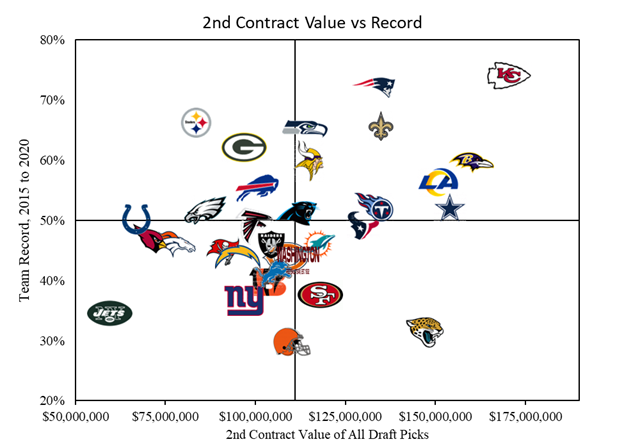
This is much more in line with what we would expect to be a driver of success in the NFL. Teams that drafted generally good players were pretty successful between 2015 and 2020 while those who didn’t were pretty bad. The QB position saved a few teams (the Packers, Steelers, etc..) including New England as well as their draft results were poor overall but their value here was driven by the inclusion of two quarterbacks who barely played with them.
While nobody really has any secret method to beat the draft you need to maximize your chances to sneak into that upper right quadrant as best you can. Teams like the Jets have basically been hopeless turning draft capital into bad selections but they should be the exception and not the rule.
It is also important to look at the teams near that bottom right quadrant. These are teams who have had a ton of draft capital and successful individual selection but poor team performance. It is basically a mirror of the top left which was bailed out by QB play. Here we have teams with, more often than not, poor QB play and no matter how good the parts may be in todays NFL there is no path to long term success when the play from the play from the position is replacement level at best. This really leads to the importance of drafting the QB until you hit one but that is a discussion for another day.